Factsheet
Minibeasts
Quite literally, a ‘minibeast’ is simply a small animal. Spiders, snails, slugs, beetles, centipedes, worms, earwigs, caterpillars are just a few.
What is a Minibeast?

Quite literally, a ‘minibeast’ is simply a small animal. Spiders, snails, slugs, beetles, centipedes, worms, earwigs, caterpillars...
Those are just a few well-known examples of the thousands and thousands of types of ‘creepy-crawlies’ that exist all over the world. Officially, minibeasts are called invertebrates which are animals without a backbone, and these are the most numerous type of animal in the world. In Britain alone there are over 25,000 species of invertebrates known. Unlike vertebrates (animals with a backbone) they do not have a skeleton inside. This makes them soft and bendy, and because of this, some of them have hard shells to live in. Some, like insects and spiders, have a thin, strong outside covering called an exoskeleton. This means they have protection for their bodies and they have legs, and often wings, which let them move more quickly and easily than other minibeasts.
Grouping Invertebrates
Minibeasts come in a huge range of size, shape and colour. They are grouped according to their characteristics. For example, the members of the largest group, the arthropods, all have legs with joints. Four classes of invertebrates belong to this group. These are:
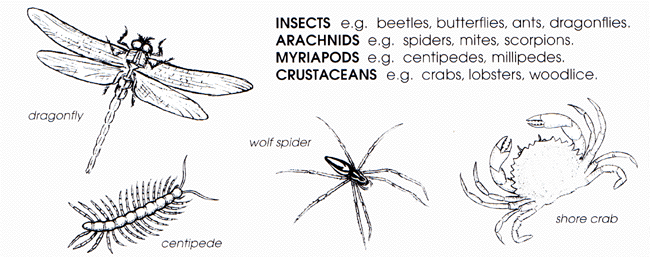
There are four more classes of invertebrates:
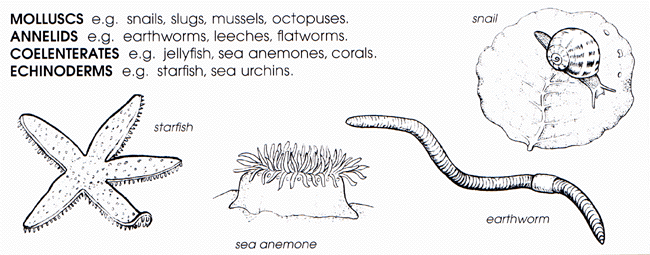
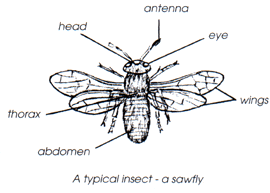 All the examples in each class have similar characteristics, although it may not seem too obvious unless you study their body structure very closely.
All the examples in each class have similar characteristics, although it may not seem too obvious unless you study their body structure very closely.
By far the largest group of all is the insects, 22,450 species living in Britain alone. To qualify as an insect, an animal must have 6 legs and a body divided into 3 parts – a head, a thorax and an abdomen.
To be an arachnid, an animal must have 8 legs. Insects and arachnids are probably the easiest minibeasts to classify.
Looking at the list of examples above you will see that invertebrates vary greatly in size, ranging from a tiny mite to a huge octopus! It’s difficult to think of an octopus as a minibeast!
Generally speaking of course, when referring to minibeasts, we are talking about the small ones we find around us, in the garden, park, countryside, school grounds and the house. It is these we will investigate in some detail.
Where do Minibeasts Live?
Minibeasts can be found in almost every part of the world. The insects and arachnids have waterproof exoskeletons which reduce water loss from their bodies, enabling them to live in the driest of ecosystems such as deserts. In Britain, large numbers of invertebrates are found in the community of every main habitat – rivers, ponds, lakes, marshes, heathlands, grasslands, woodlands, hedgerows, seashores – as well as people’s gardens and buildings.
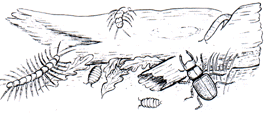 Micro-habitats are parts of larger habitats. A log is an example of a micro-habitat and many minibeasts may be found living underneath it. The log may, however, be in a wood or a garden in which a larger community lives.
Micro-habitats are parts of larger habitats. A log is an example of a micro-habitat and many minibeasts may be found living underneath it. The log may, however, be in a wood or a garden in which a larger community lives.
Other micro-habitats providing suitable homes for invertebrates are stones, bushes, trees, grass, flowers, soil and leaf litter (dead leaves on the ground).
HABITAT – the non-living surroundings (environment) in which an animal or plant lives. All the animals and plants in the habitat make up the COMMUNITY and they are specially adapted for coping with the conditions in the habitat, such as the type of soil, the water, the air and the temperature. So a woodland is the habitat of a stag beetle and a pond is the habitat of a diving beetle.
ECOSYSTEM – a community of plants and animals interacting with one another, plus the habitat in which they live and with which they also interact.
ECOSYSTEM = HABITAT + COMMUNITY
If you study the way in which animals and plants live with one another and with their environment, you are studying the balance of nature – or ECOLOGY.
What do Minibeasts Eat?
 Many invertebrates eat only plants, and they, like all plant-eating animals, are called herbivores. Many eat a wide range of plant food, especially leaves, but some feed on only fruit, nectar or pollen. Molluscs and insects are the only classes of invertebrates which have developed mouthparts capable of grinding up the tough tissues of green leaves. Grasshoppers and caterpillars have mouthparts with very sharp edges for cutting into leaves. Slugs and snails have a very efficient rasping organ called a radula, which is a bit like a conveyor-belt which tears up plant food.
Many invertebrates eat only plants, and they, like all plant-eating animals, are called herbivores. Many eat a wide range of plant food, especially leaves, but some feed on only fruit, nectar or pollen. Molluscs and insects are the only classes of invertebrates which have developed mouthparts capable of grinding up the tough tissues of green leaves. Grasshoppers and caterpillars have mouthparts with very sharp edges for cutting into leaves. Slugs and snails have a very efficient rasping organ called a radula, which is a bit like a conveyor-belt which tears up plant food.
The mouthparts of some insects are specially adapted for feeding on the sap and nectar of plants. Aphids e.g. greenfly and blackfly, have piercing mouthparts which draw up sap from a plant stem. Butterflies and moths have a long thin tongue (a proboscis) which they use to reach into flowers and suck out the nectar. When not in use the proboscis is curled up like a watch spring. Some butterflies enjoy the juice from rotting fruit.
Herbivorous minibeasts have to keep a watchful eye out for meat-eating minibeasts – the carnivores. For their size, carnivorous minibeasts are powerful and ferocious predators.. Some of them are active hunters, being able to move fast in pursuit of their prey, whilst others set traps to catch their victims.
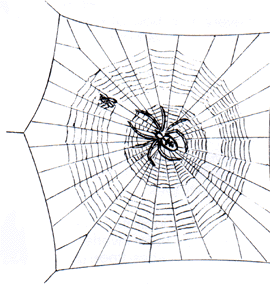 Some spiders are hunters and some are trappers. The wolf spider lies in wait, often among dead leaves on the woodland floor, ready to jump out and chase its prey.
Some spiders are hunters and some are trappers. The wolf spider lies in wait, often among dead leaves on the woodland floor, ready to jump out and chase its prey.
Other spiders spin webs with sticky threads to trap flying insects. Once the victim is trapped, the spider paralyses it with a bite. Then it wraps the insect in silk and injects it with enzymes that break down its body into a liquid which the spider can suck up.
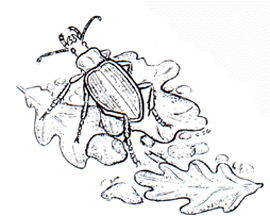 Ground beetles run fast on long legs and hunt at night. They have powerful, sharp jaws for grabbing and crushing other insects and slugs. There are 352 species of ground beetle in Britain, and most species are specially adapted for a life on the ground. Some, like the violet ground beetle, cannot fly as their wing cases (elytra) are joined together. During the day ground beetles hide under logs, stones and dead leaves.
Ground beetles run fast on long legs and hunt at night. They have powerful, sharp jaws for grabbing and crushing other insects and slugs. There are 352 species of ground beetle in Britain, and most species are specially adapted for a life on the ground. Some, like the violet ground beetle, cannot fly as their wing cases (elytra) are joined together. During the day ground beetles hide under logs, stones and dead leaves.
Dragonflies are specially adapted for hunting on the wing. They have enormous eyes and strong wings which help them spot and chase other flying insects. They can spot prey 12 metres away in almost any direction. To help them scoop up the prey in the air, their legs are spread out like a basket. Strong, biting mouth parts deal with the captured insect. Dragonfly larvae live in freshwater ponds and they are also carnivorous. In fact, there are several fierce carnivorous minibeasts to be found in ponds – diving beetle, water boatman, water scorpion and pond skater to name but a few.
Other predatory invertebrates on land include centipedes, harvestmen and several other species of beetles – ladybirds, soldier beetles and rove beetles.
Why are Minibeasts Important?
 Some people regard most ‘creepy crawlies’ simply as pests, in need of extermination! Indeed some of them can be pests to us humans, spreading diseases and eating our crops, but in fact, all invertebrates are a very important part of life in the habitat in which they live. We will take a woodland as an example.
Some people regard most ‘creepy crawlies’ simply as pests, in need of extermination! Indeed some of them can be pests to us humans, spreading diseases and eating our crops, but in fact, all invertebrates are a very important part of life in the habitat in which they live. We will take a woodland as an example.
Invertebrates are found in all layers, from the floor to the canopy (branches and leaves of the trees) and they are a very important source of food for several mammals and birds. Some birds feed only on insects and most seed-eating birds feed their babies on insects. Hundreds of different butterflies and moths lay eggs on the leaves of the trees. When the caterpillars hatch they feed in huge numbers on the leaves. During the summer, a large oak tree can support 400,000 caterpillars at any one time! If all these caterpillars survived, then the trees would be stripped bare of leaves. Before this happens, the population of small woodland birds usually increases and many of the caterpillars are eaten.
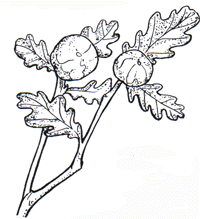 Many other invertebrates live amongst the canopy; wasps, flies beetles, weevils and bugs such as aphids, may all be found there. The larvae of some of these tunnel into leaves as they feed whilst others produce swellings or ‘galls’ on the leaf buds, flower buds or leaf surface. These herbivorous minibeasts are preyed on by carnivorous minibeasts such as ladybirds, lacewings, ants, mites and bush crickets. Small birds will eat most of these invertebrates.
Many other invertebrates live amongst the canopy; wasps, flies beetles, weevils and bugs such as aphids, may all be found there. The larvae of some of these tunnel into leaves as they feed whilst others produce swellings or ‘galls’ on the leaf buds, flower buds or leaf surface. These herbivorous minibeasts are preyed on by carnivorous minibeasts such as ladybirds, lacewings, ants, mites and bush crickets. Small birds will eat most of these invertebrates.
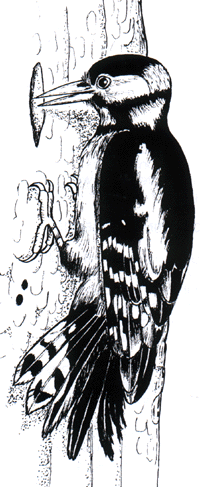
Some beetle larvae have strong jaws so they can munch their way through the wood of a tree trunk, making a network of tunnels as they feed. These wood-boring beetles are hunted by woodpeckers, such as the great spotted woodpecker, which drills beneath the bark with its powerful beak to find them.
The leaf litter and soil of the woodland floor provide homes for thousands of minibeasts. Others live in and under rotting logs. Slugs, snails, earthworms, millipedes, mites, springtails, woodlice, ants, beetles and fly larvae all feed on dead leaves which fall from the trees. These invertebrates are hunted by the carnivorous beetles, centipedes, spiders and harvestmen.
Many of the minibeasts which live in leaf litter are classed as decomposers and they have a very important job to do in an ecosystem. As well as feeding on dead leaves, some of them also eat dead trees and the droppings and dead bodies of animals. In fact, any waste plant and animal material is eaten. All waste material still contains nutrients. The minibeasts break the material into tiny bits and use some of the nutrients in them for themselves. The fragments left are then easier for microscopic worms, fungi and bacteria to feed on and break down even more, releasing nutrients into the soil. The plants soon absorb these nutrients, and so the cycle continues. If the decomposers did not exist, then nothing would rot down and we would be surrounded by piles of dead bodies! Next time you try to swat a fly, remember that although it may be a nuisance to you, it is also one of nature’s recyclers’!
Minibeasts in Food Chains
The mini-predators in the leaf litter are, in turn, eagerly eaten by larger carnivores, such as birds, lizards, weasels, badgers and foxes. When a herbivore eats a plant….and then a carnivore eats the herbivore….the sequence of events is called a food chain. Each plant or animal is a link in the chain. Invertebrates are involved in the thousands of food chains that exist in every ecosystem. Here is a five-link chain involving a herbivorous minibeast and a carnivorous one:-

The ground beetle, the shrew and the fox will all eat other animals too. There are so many connections between food chains that we should really think of every plant and animal as part of a complicated food web, rather than as a link in a straight chain. Minibeasts are, of course, very important members of a food web.
Collecting Minibeasts
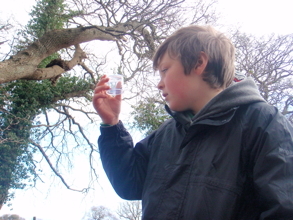 Many minibeasts either hibernate or spend the winter as eggs or pupae, so the best time of year to go out and study these creatures is when the weather is warm, from late spring into the summer. Minibeasts, particularly insects, can be found almost anywhere. You will be able to observe butterflies, bees, wasps, other small insects and some spiders simply by watching patches of flowering plants in the garden. If you can see a minibeast clearly, don’t try to catch it. Remember that bees and wasps can sting! Always put caterpillars back on the plant that you found them on.
Many minibeasts either hibernate or spend the winter as eggs or pupae, so the best time of year to go out and study these creatures is when the weather is warm, from late spring into the summer. Minibeasts, particularly insects, can be found almost anywhere. You will be able to observe butterflies, bees, wasps, other small insects and some spiders simply by watching patches of flowering plants in the garden. If you can see a minibeast clearly, don’t try to catch it. Remember that bees and wasps can sting! Always put caterpillars back on the plant that you found them on.
See how many minibeasts you can find in the leaves of a tree by holding a large white sheet under the lowest branches and giving them a good shake. Among the creatures that fall onto your sheet you may find beetles, spiders, lacewings, gall wasps, fruit flies, weevils and green caterpillars.
A pond is another good minibeast habitat and the best way to find out about the minibeasts in a pond is to arm yourself with a net, a large bowl or shallow tray, a magnifying glass and a notebook and go pond dipping. Remember to return all the animals to the water when you have finished.
The dark, damp conditions underneath a rotting log attract slugs, beetles, centipedes, millipedes, woodlice and a host of smaller minibeasts. Carefully roll aside a log to search for these creatures – but be sure to replace the log exactly where you found it to avoid destroying their micro-habitat.
Try setting traps for slugs in the garden. These molluscs need moisture so they prefer dark, damp places. Experiment with different types of traps which create these conditions – perhaps half a grapefruit skin (open side placed downwards), a sheet of black plastic or a flat piece of wood. Place the traps near some plants, preferably leafy vegetables, on a warm, wet day and leave them overnight. Examine the traps the next morning and see which one was the most successful. The slugs may try to eat the inside of the grapefruit skin. Other nocturnal, damp-loving minibeasts may be attracted to your traps too.
Looking Closely at Minibeasts in Leaf Litter
Many invertebrates live hidden from view in the layer of leaf litter on the woodland floor or at the bottom of a hedge. One way to find some of these is to set a pitfall trap. To do this, dig a small hole in the ground and bury a plastic cup, or similar container, up to the rim. Protect the trap from rain by making a roof with a piece of raised wood or slate. A piece of meat or cheese may tempt some minibeasts into your trap. Leave the trap overnight and check the next morning for any animals that may have fallen in during the night. Empty the container into a light-coloured dish and have a close look at them, using a magnifying glass. Return the captives to their habitat when you have finished with them.
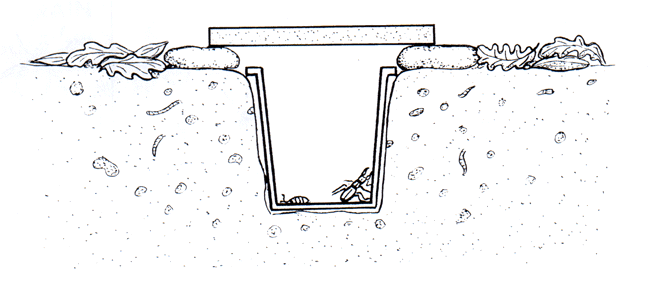
The pitfall trap will only catch those minibeasts that run about over the surface of the leaf litter. Many more live buried deep in the litter. To find these, collect some damp, rotting leaves from beneath the top dry surface and put them into a plastic bag. Take the bag home and empty the contents, a bit at a time, into an old sieve. Shake the smaller creatures into a shallow tray or onto a large sheet of white paper. Turn over the leaves in the tray and gently pick out any worms or other larger minibeasts. A paintbrush is useful for picking up tiny animals and transferring them into pots for examination with a hand lens. When you have finished, return all the minibeasts to the place you found them.
Identifying Minibeasts
You will probably be able to name some of the more common invertebrates you find but there may be several you cannot put a name to. An identification book will help you but you can also use a key. Here is one specially designed to identify the more common animals found living in leaf letter.
When using the key you have first to decide whether the unknown creature has legs or not. Having decided that, follow the key down until you arrive at the name of that creature.
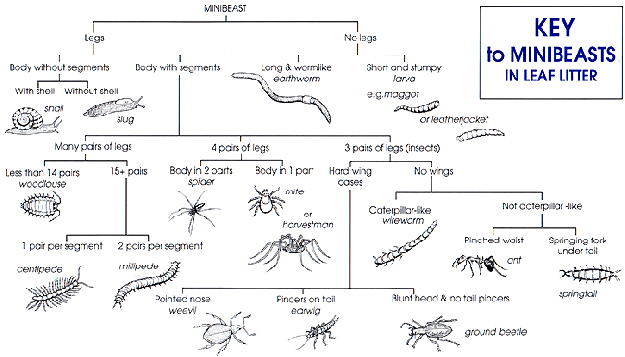
Credits
Image: Minibeasts by BuildArk




 All the examples in each class have similar characteristics, although it may not seem too obvious unless you study their body structure very closely.
All the examples in each class have similar characteristics, although it may not seem too obvious unless you study their body structure very closely. Micro-habitats are parts of larger habitats. A log is an example of a micro-habitat and many minibeasts may be found living underneath it. The log may, however, be in a wood or a garden in which a larger community lives.
Micro-habitats are parts of larger habitats. A log is an example of a micro-habitat and many minibeasts may be found living underneath it. The log may, however, be in a wood or a garden in which a larger community lives. Many invertebrates eat only plants, and they, like all plant-eating animals, are called herbivores. Many eat a wide range of plant food, especially leaves, but some feed on only fruit, nectar or pollen. Molluscs and insects are the only classes of invertebrates which have developed mouthparts capable of grinding up the tough tissues of green leaves. Grasshoppers and caterpillars have mouthparts with very sharp edges for cutting into leaves. Slugs and snails have a very efficient rasping organ called a radula, which is a bit like a conveyor-belt which tears up plant food.
Many invertebrates eat only plants, and they, like all plant-eating animals, are called herbivores. Many eat a wide range of plant food, especially leaves, but some feed on only fruit, nectar or pollen. Molluscs and insects are the only classes of invertebrates which have developed mouthparts capable of grinding up the tough tissues of green leaves. Grasshoppers and caterpillars have mouthparts with very sharp edges for cutting into leaves. Slugs and snails have a very efficient rasping organ called a radula, which is a bit like a conveyor-belt which tears up plant food. Some spiders are hunters and some are trappers. The wolf spider lies in wait, often among dead leaves on the woodland floor, ready to jump out and chase its prey.
Some spiders are hunters and some are trappers. The wolf spider lies in wait, often among dead leaves on the woodland floor, ready to jump out and chase its prey. Ground beetles run fast on long legs and hunt at night. They have powerful, sharp jaws for grabbing and crushing other insects and slugs. There are 352 species of ground beetle in Britain, and most species are specially adapted for a life on the ground. Some, like the violet ground beetle, cannot fly as their wing cases (elytra) are joined together. During the day ground beetles hide under logs, stones and dead leaves.
Ground beetles run fast on long legs and hunt at night. They have powerful, sharp jaws for grabbing and crushing other insects and slugs. There are 352 species of ground beetle in Britain, and most species are specially adapted for a life on the ground. Some, like the violet ground beetle, cannot fly as their wing cases (elytra) are joined together. During the day ground beetles hide under logs, stones and dead leaves. Some people regard most ‘creepy crawlies’ simply as pests, in need of extermination! Indeed some of them can be pests to us humans, spreading diseases and eating our crops, but in fact, all invertebrates are a very important part of life in the habitat in which they live. We will take a woodland as an example.
Some people regard most ‘creepy crawlies’ simply as pests, in need of extermination! Indeed some of them can be pests to us humans, spreading diseases and eating our crops, but in fact, all invertebrates are a very important part of life in the habitat in which they live. We will take a woodland as an example. Many other invertebrates live amongst the canopy; wasps, flies beetles, weevils and bugs such as aphids, may all be found there. The larvae of some of these tunnel into leaves as they feed whilst others produce swellings or ‘galls’ on the leaf buds, flower buds or leaf surface. These herbivorous minibeasts are preyed on by carnivorous minibeasts such as ladybirds, lacewings, ants, mites and bush crickets. Small birds will eat most of these invertebrates.
Many other invertebrates live amongst the canopy; wasps, flies beetles, weevils and bugs such as aphids, may all be found there. The larvae of some of these tunnel into leaves as they feed whilst others produce swellings or ‘galls’ on the leaf buds, flower buds or leaf surface. These herbivorous minibeasts are preyed on by carnivorous minibeasts such as ladybirds, lacewings, ants, mites and bush crickets. Small birds will eat most of these invertebrates.

 Many minibeasts either hibernate or spend the winter as eggs or pupae, so the best time of year to go out and study these creatures is when the weather is warm, from late spring into the summer. Minibeasts, particularly insects, can be found almost anywhere. You will be able to observe butterflies, bees, wasps, other small insects and some spiders simply by watching patches of flowering plants in the garden. If you can see a minibeast clearly, don’t try to catch it. Remember that bees and wasps can sting! Always put caterpillars back on the plant that you found them on.
Many minibeasts either hibernate or spend the winter as eggs or pupae, so the best time of year to go out and study these creatures is when the weather is warm, from late spring into the summer. Minibeasts, particularly insects, can be found almost anywhere. You will be able to observe butterflies, bees, wasps, other small insects and some spiders simply by watching patches of flowering plants in the garden. If you can see a minibeast clearly, don’t try to catch it. Remember that bees and wasps can sting! Always put caterpillars back on the plant that you found them on.

